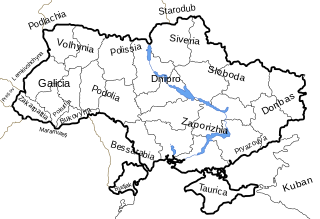 W
WAdministrative division of regions of Ukraine is not homogeneous, but it is standardized. There are three types of regional subdivisions: raion, raion within city, and city of regional significance (jurisdiction).
 W
WUkraine is administratively divided into 27 regions, one of which is an autonomous republic, the Autonomous Republic of Crimea. Its administrative status is recognized in the Ukrainian Constitution in Chapter X: Autonomous Republic of Crimea and is governed in accordance with laws passed by Ukraine's parliament, the Verkhovna Rada. Following the 2014 Crimean crisis the Autonomous Republic of Crimea was annexed by Russia as the Republic of Crimea. In 2016, the UN General Assembly reaffirmed non-recognition of the annexation and condemned "the temporary occupation of part of the territory of Ukraine—the Autonomous Republic of Crimea and the city of Sevastopol".
 W
WThe following is a list of place names in Canada whose name origin is in the Ukrainian language. Some places – especially in Saskatchewan – were named by ethnic Germans from Ukraine.
 W
WThe Dnieper or Dnipro(other names) is one of the major rivers of Europe, rising in the Valdai Hills near Smolensk, Russia, before flowing through Belarus and Ukraine to the Black Sea. It is the longest river of Ukraine and Belarus and the fourth-longest river in Europe. The total length is approximately 2,200 km (1,400 mi) with a drainage basin of 504,000 square kilometres (195,000 sq mi). Historically, the river was an important barrier, dividing Ukraine into right and left banks. Nowadays, the river is noted for its dams and hydroelectric stations. The Dnieper is an important navigable waterway for the economy of Ukraine and is connected via the Dnieper–Bug Canal to other waterways in Europe.
 W
WThis is a list of all current crossings of the Dnieper River which begins at the Dnieper River's crossing a Belarus-Ukraine border and extends to its river delta near the Dnieper Estuary at Kherson. Some historic achievements, explanatory notes and proposed crossings are also included.
 W
WA list of the various regions of Ukraine and/or inhabited by Ukrainians and their ancestors throughout history.
 W
WOn July 17, 2020, by the Resolution of the Verkhovna Rada of Ukraine № 807-IX “On formation and liquidation of districts”, instead of 490 districts, 136 new districts with smaller powers were created, as the main powers of raions were passed to lower (communities) and higher (oblasts) levels.
 W
WCity with special status refers to two of Ukraine's 27 administrative regions, which are the cities of Kyiv and Sevastopol. Their administrative status is recognized in the Ukrainian Constitution in Chapter IX: Territorial Structure of Ukraine and they are governed in accordance with laws passed by Ukraine's parliament, the Verkhovna Rada.
 W
WAn oblast, in English referred to as a region, refers to one of Ukraine's 24 primary administrative units. Ukraine is a unitary state, thus the regions do not have much legal scope of competence other than that which is established in the Ukrainian Constitution and by law. Articles 140–146 of Chapter XI of the constitution deal directly with local authorities and their competency.
 W
WRaions of Ukraine are the second level of administrative division in Ukraine, below the oblast.
 W
WCity of regional significance was a city municipality that was designated as a separate district within its region. In Crimea, these cities were referred to as cities of republican significance, while in regular oblasts those municipalities were referred to as cities of oblast significance. The designation of regional significance was created with the introduction of oblasts in 1932 and abolished in 2020 following a new administrative reform that reshaped raions.
 W
WAn amalgamated hromada or amalgamated territorial community, also known as a united territorial community, is a basic unit of administrative division in Ukraine. First created in 2015, amalgamated hromadas are formed through the voluntary merger of preexisting hromadas, a form of third-level administrative unit including cities, villages, urban-type settlements, and rural settlements, to form a new enlarged administrative unit. According to December 2019 draft constitutional changes submitted to parliament by President Volodymyr Zelensky amalgamated hromadas are planned to replace the Raions of Ukraine as a second-level administrative unit. On 6 March 2020 Prime Minister Denys Shmyhal stated that 1,045 amalgamated hromadas had been established and that 350 more had to be created. The amalgamated hromadas have already taken over most tasks of the raions.